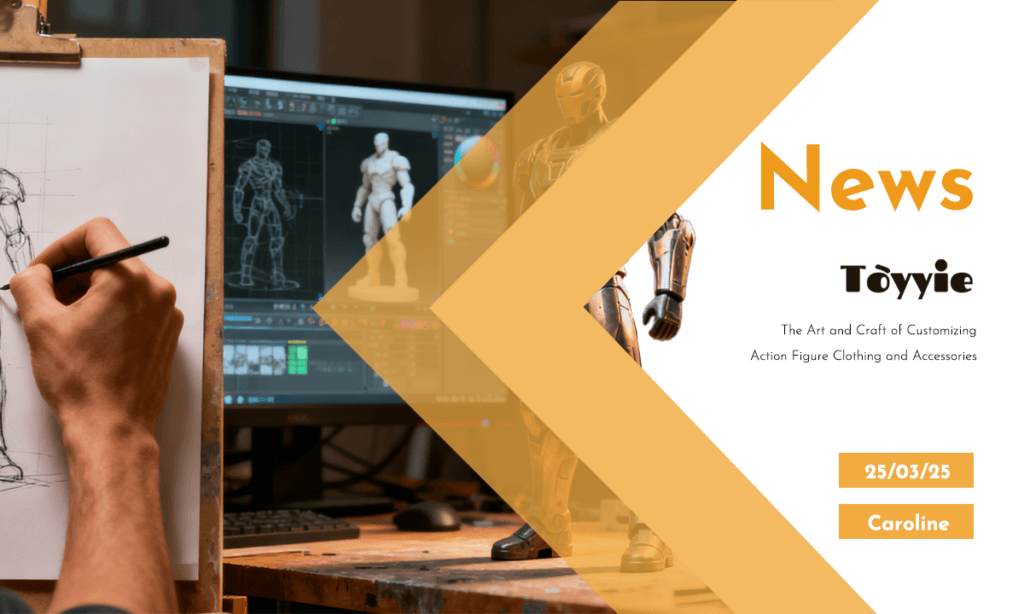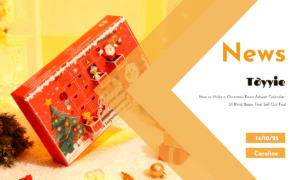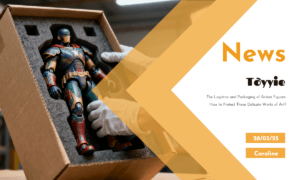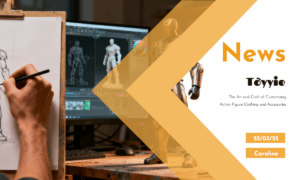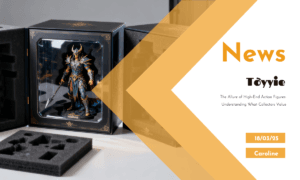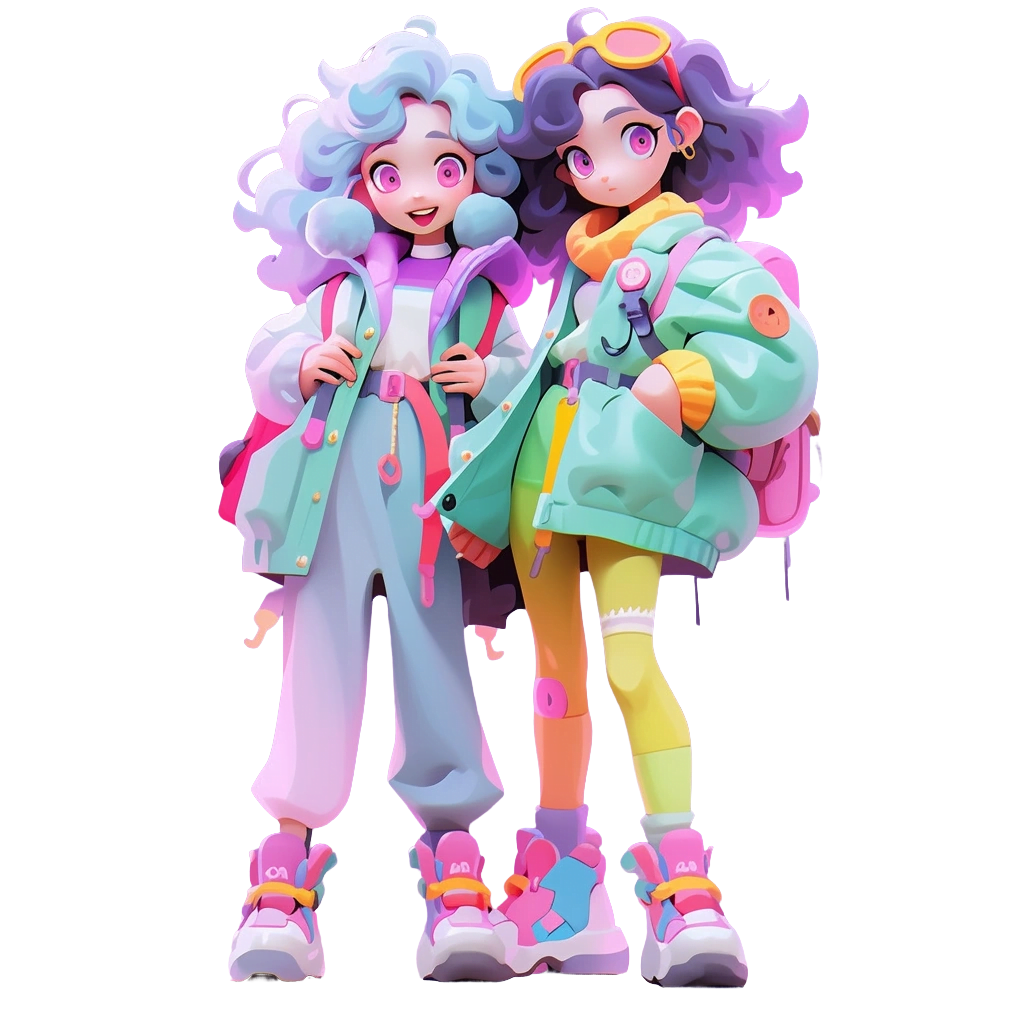📌 Introduction📌
In the world of action figures, customization stands as a pinnacle of creativity and craftsmanship. For collectors and enthusiasts, the ability to tailor clothing and accessories not only enhances the aesthetic appeal of their figures but also adds a layer of personalization that transforms these miniature works of art into unique expressions of individuality. From my extensive experience in designing and producing custom action figure outfits, I have witnessed firsthand how the right choice of materials and meticulous attention to detail can elevate a simple figure into a masterpiece.
The journey of customizing action figure clothing begins with understanding the importance of fabric selection. Each type of fabric brings its own texture, weight, and drape, which can dramatically affect the final look and feel of the outfit. For instance, cotton is often chosen for its softness and ease of handling, making it ideal for casual wear on action figures. On the other hand, silk or satin might be selected for more formal attire due to their lustrous finish and elegant flow. The decision on fabric goes beyond mere aesthetics; it involves considering how well the material holds up under the stress of posing and reposing the figure without losing its shape or color.
Beyond fabrics, the intricacies of accessory design play a crucial role in the overall customization process. Accessories such as belts, hats, and jewelry not only complement the clothing but also add depth and realism to the character portrayal. Crafting these elements requires a keen eye for detail and a steady hand, especially when working with small-scale items that demand precision. Techniques like hand-painting, embroidery, and the use of miniature embellishments can turn a simple accessory into a standout feature of the figure’s ensemble.
Color coordination is another critical aspect that cannot be overlooked. The right color palette can enhance the visual impact of an action figure, creating a harmonious blend that resonates with the character’s backstory or setting. Whether aiming for historical accuracy, thematic consistency, or simply a striking visual effect, the thoughtful pairing of colors in both clothing and accessories ensures that each element contributes to a cohesive and compelling whole.
Through this exploration of fabric choices, accessory crafting, and color strategies, we will delve deeper into the techniques and insights that define successful action figure customization. By sharing these experiences and tips, the aim is to equip enthusiasts with the knowledge and inspiration needed to embark on their own creative journeys, transforming their action figures into personalized treasures that reflect their unique tastes and artistic visions.
Selecting the Right Fabrics for Action Figure Outfits 🧵
When it comes to customizing action figure clothing, the choice of fabric is paramount. Each fabric type offers distinct characteristics that can significantly influence the appearance and functionality of the outfit. Understanding these differences is essential for achieving the desired effect in your custom designs.
1.1. Cotton
Known for its versatility and comfort, cotton is a popular choice for action figure clothing. Its natural fibers provide a soft texture that drapes well, making it suitable for a wide range of garments from casual wear to structured pieces. Cotton’s ability to hold dye also makes it excellent for vibrant colors, which are crucial for bringing characters to life. However, cotton can wrinkle easily, so it may require careful handling to maintain a polished look on smaller scales.
1.2. Silk and Satin
These luxurious fabrics are favored for their smooth texture and glossy sheen, ideal for depicting elegance and sophistication. Silk, in particular, has a natural luster that adds a touch of realism to formal attire, such as gowns or suits. Satin, being slightly stiffer, holds shapes well, which is beneficial for creating structured garments like corsets or jackets. Both materials, however, are delicate and can be challenging to work with due to their slippery nature and tendency to fray.
1.3. Leather and Faux Leather
For action figures that require a rugged or edgy look, leather and faux leather are excellent options. They provide a tough, durable surface that mimics real-world materials used in jackets, boots, and armor. Faux leather, while easier to handle than genuine leather, still maintains a similar aesthetic and can be shaped and sewn with relative ease, making it a practical choice for intricate designs.
1.4. Wool and Tweed
When aiming for a vintage or rustic appearance, wool and tweed offer textures that are hard to replicate with other fabrics. Wool’s thickness and warmth make it perfect for coats and capes, giving them a substantial feel that enhances the figure’s presence. Tweed, with its characteristic weave, adds a layer of authenticity to period costumes, capturing the essence of classic styles.
Each fabric not only affects the visual outcome but also interacts differently with the small scale and articulated joints of action figures. Choosing the right material involves balancing aesthetic desires with practical considerations such as durability and ease of manipulation. As you experiment with different fabrics, consider how they respond to movement and stress, ensuring that your custom outfits not only look great but also function seamlessly with the figure’s dynamic poses.
By carefully selecting fabrics based on their properties and how they align with your design goals, you can craft outfits that not only fit perfectly but also enhance the storytelling potential of each action figure. This thoughtful approach to fabric choice lays the groundwork for creating truly captivating and personalized miniatures.
Mastering the Details: Techniques for Crafting Accessories and Embellishments 🔨
In the realm of action figure customization, accessories and embellishments serve as the finishing touches that transform a simple outfit into a narrative-rich ensemble. These elements not only complement the clothing but also imbue the character with personality and depth. Mastering the creation of these details requires a combination of technical skill, artistic vision, and innovative techniques. Here, we explore some advanced methods for crafting accessories and embellishments, along with examples of how these techniques can elevate your designs.
2.1. Hand-Painting: Adding Intricate Patterns and Textures
Hand-painting is one of the most versatile techniques for adding fine details to accessories. Whether it’s painting intricate patterns on a belt buckle or adding weathering effects to armor, this method allows for unparalleled customization. For example, in a recent project involving a fantasy-themed warrior figure, we used hand-painting to create metallic accents on the figure’s shield and sword. By layering metallic paints and using dry-brushing techniques, we achieved a realistic aged-metal effect that enhanced the character’s battle-worn appearance.
To execute hand-painting effectively, start with high-quality acrylic paints, which adhere well to most surfaces and dry quickly. Use fine brushes with pointed tips for precision, and always work in layers—beginning with a base coat and gradually building up highlights and shadows. For added realism, consider incorporating weathering techniques, such as stippling or sponge dabbing, to simulate scratches, dirt, or rust.
2.2. Embroidery: Elevating Fabric with Dimensional Detail
Embroidery is a timeless technique that adds texture and dimension to fabric accessories. It’s particularly effective for creating elaborate designs on items like capes, sashes, or even small patches. One memorable project involved embroidering a family crest onto the cape of a medieval knight figure. Using a combination of satin stitches and French knots, we created a richly detailed emblem that conveyed the character’s noble heritage.
For small-scale embroidery, a fine needle and thin thread are essential. Begin by sketching your design onto the fabric using a water-soluble pen or chalk. Then, secure the fabric in a small embroidery hoop to prevent puckering. Work slowly and steadily, focusing on maintaining consistent tension in your stitches. If you’re new to embroidery, start with simpler designs before progressing to more complex patterns.
2.3. Miniature Embellishments: Adding Sparkle and Shine
Miniature embellishments—such as beads, sequins, and rhinestones—are perfect for adding sparkle and shine to accessories. These tiny details can transform a plain piece into something extraordinary. For instance, in a project featuring a glamorous superheroine figure, we adorned her mask and gloves with micro-rhinestones to create a dazzling effect. The reflective quality of the stones caught the light beautifully, enhancing the figure’s dynamic presence.
When working with miniature embellishments, precision is key. Use a pair of fine-tipped tweezers to handle small components, and apply adhesive sparingly to avoid excess glue seeping through the fabric. For a seamless finish, consider using clear-drying adhesives specifically designed for delicate materials. Additionally, pre-plan your design layout to ensure symmetry and balance, especially when working with repetitive patterns.
2.4. Sculpting and Casting: Creating Custom Accessories
For accessories that require a three-dimensional form, sculpting and casting offer limitless possibilities. This technique is ideal for crafting items like helmets, weapons, or jewelry that need to match specific character designs. In one ambitious project, we created a custom tiara for a royal-themed figure by sculpting the initial design in clay, creating a silicone mold, and then casting the final piece in resin. The result was a lightweight yet durable accessory that perfectly matched the character’s regal aesthetic.
To begin sculpting, choose a modeling material that suits your needs—epoxy putty is excellent for beginners due to its ease of use and strong curing properties. Once your design is complete, create a mold using food-safe silicone, which captures even the finest details. After the mold sets, pour in your casting material (resin, polymer clay, etc.) and allow it to cure according to the manufacturer’s instructions. Sand and paint the finished piece as needed to achieve the desired finish.
2.5. Layering and Texturing: Building Depth in Accessories
Layering and texturing techniques can add depth and realism to accessories, making them appear more lifelike. For example, in a project involving a post-apocalyptic scavenger figure, we layered torn fabric strips over a leather vest to simulate a rugged, patched-together look. We also added texture by distressing the edges of the fabric with sandpaper and applying subtle washes of paint to mimic dirt and grime.
To achieve layered effects, experiment with combining different materials, such as fabric, leather, and metal foil. Use adhesives strategically to create folds, wrinkles, or uneven surfaces that mimic natural wear and tear. For texturing, tools like embossing stamps, heat guns, and sandpaper can help achieve various finishes, from cracked leather to frayed threads.
2.6. Functional Accessories: Enhancing Playability
While aesthetics are important, functional accessories can also enhance the playability of an action figure. Items like removable backpacks, interchangeable weapon parts, or adjustable belts allow collectors to customize their figures further. In a recent collaboration, we designed a modular utility belt for a tactical-themed figure. The belt featured detachable pouches and holsters, enabling users to rearrange the layout based on their preferences.
When designing functional accessories, prioritize ease of use and durability. Ensure that moving parts are securely attached but still flexible enough to withstand repeated handling. Test prototypes rigorously to identify any weak points, and refine the design accordingly.
By mastering these techniques, you can create accessories and embellishments that not only enhance the visual appeal of your action figures but also deepen their storytelling potential. Each detail—from a hand-painted emblem to a meticulously embroidered pattern—contributes to the overall narrative, allowing your creations to resonate with collectors and enthusiasts alike. As you continue to hone your skills, remember that experimentation and creativity are your greatest allies in the pursuit of crafting truly exceptional accessories.
Harmonizing Colors: The Role of Color Coordination in Action Figure Customization 🎨
In the intricate process of customizing action figures, color coordination plays a pivotal role in defining the visual impact and emotional resonance of the final product. A well-thought-out color scheme not only enhances the aesthetic appeal of the figure but also aligns with the character’s narrative, setting, or thematic elements. Drawing from my extensive experience in designing custom outfits for action figures, I’ve observed how strategic color choices can transform a figure from a mere collectible into a storytelling masterpiece.
3.1. Establishing Character Identity Through Color
Colors are powerful tools for conveying personality traits and background stories. For instance, bold and vibrant hues like red, gold, and deep blue are often associated with heroic characters, evoking feelings of courage, strength, and nobility. Conversely, darker shades such as black, gray, and muted greens are frequently used to depict villains or anti-heroes, suggesting mystery, danger, or moral ambiguity. In one project, we customized a superhero figure inspired by a comic book series. By dressing the character in a predominantly red and blue outfit accented with gold trim, we reinforced their identity as a protector and leader within their fictional universe. The gold accents symbolized authority and honor, while the primary colors emphasized their role as a beacon of hope.
3.2. Creating Visual Cohesion Across Outfits and Accessories
Achieving visual cohesion between clothing and accessories is essential for a polished and professional look. This involves selecting colors that complement each other rather than compete for attention. For example, if the main outfit features a neutral palette like beige or taupe, accessories in earthy tones such as brown leather belts or green gemstone jewelry can create a harmonious blend. On the other hand, if the clothing incorporates bright, saturated colors, accessories should either echo those hues or provide a subtle contrast to avoid overwhelming the viewer’s eye.
A notable case involved a fantasy-themed figure dressed in a flowing emerald-green gown. To maintain balance, we paired the dress with accessories in complementary jewel tones, including amethyst earrings and a sapphire pendant. These additions enhanced the regal aura of the character without detracting from the gown’s prominence. Additionally, metallic accents in silver and gold were used sparingly to highlight key areas, such as the neckline and cuffs, creating focal points that drew attention to the figure’s intricate details.
3.3. Utilizing Color Theory for Dynamic Effects
Understanding basic principles of color theory can elevate your customization projects to new heights. Concepts such as complementary colors (opposite on the color wheel), analogous colors (adjacent on the color wheel), and triadic schemes (three evenly spaced colors) provide frameworks for creating visually striking combinations. For instance, pairing complementary colors like orange and blue can generate a high-contrast effect that makes the figure stand out, while analogous colors like yellow, orange, and red create a warm, cohesive look that feels inviting and energetic.
In a recent project, we applied a triadic color scheme to a futuristic sci-fi figure. The outfit combined shades of purple, green, and orange, resulting in a vibrant yet balanced appearance. The purple served as the dominant color, representing innovation and technology, while the green and orange acted as secondary accents, symbolizing growth and energy. This approach not only made the figure visually appealing but also reinforced its connection to the sci-fi genre, where bold and unconventional designs are celebrated.
3.4. Considering Lighting and Display Conditions
The environment in which an action figure is displayed can significantly influence how colors are perceived. Factors such as ambient lighting, background colors, and proximity to other objects all play a role in shaping the viewer’s experience. For example, figures displayed under warm, yellow-toned lights may appear more vibrant and inviting, while cool, blue-toned lights can emphasize a sleek, modern aesthetic. Similarly, placing a figure against a neutral backdrop allows its colors to take center stage, whereas a busy or colorful background might distract from the outfit’s details.
During one exhibition, we showcased a series of figures dressed in monochromatic outfits—each in a single dominant color like crimson, navy, or forest green. To maximize their impact, we arranged them against minimalist white pedestals and illuminated them with spotlights. This setup highlighted the purity and intensity of the colors, drawing viewers’ attention to the craftsmanship and design of each piece. By tailoring the display conditions to complement the figures’ color schemes, we ensured that their visual appeal was fully realized.
3.5. Adapting Colors to Reflect Themes and Settings
Finally, color coordination should always align with the overarching themes and settings of the character or story. Historical figures, for example, benefit from palettes that reflect the time period and cultural context. Earthy browns, deep reds, and muted blues might evoke the Renaissance era, while pastels and soft neutrals capture the elegance of the Victorian age. Similarly, characters rooted in specific environments—such as jungle explorers or desert wanderers—can be enhanced by incorporating colors inspired by their surroundings, such as lush greens or sandy tans.
One memorable project involved customizing a figure based on a legendary pirate captain. To capture the essence of the high seas, we chose a palette dominated by navy blue, ivory, and brass accents. The navy represented the vast ocean, the ivory mimicked weathered sails, and the brass echoed the glint of treasure and weaponry. These deliberate choices immersed the figure in its maritime setting, making it instantly recognizable as part of a swashbuckling tale.
By thoughtfully integrating color coordination into your customization process, you can create action figures that not only captivate visually but also tell compelling stories. Whether you’re aiming to establish character identity, achieve visual cohesion, or adapt to specific themes, color remains a cornerstone of successful design. As you experiment with different palettes and techniques, remember that every hue carries meaning—and every choice contributes to the larger narrative of your creation.
Overcoming Challenges in Action Figure Customization: Expert Solutions and Insights 🛠️
Customizing action figures is a rewarding yet intricate process, often fraught with challenges that test the patience and creativity of even the most experienced designers. From fabric shrinkage and dye bleeding to mismatched accessories and color inconsistencies, these obstacles can derail a project if not addressed proactively. Drawing from years of hands-on experience, I’ll share practical solutions and expert advice to help you navigate these common issues and achieve flawless results in your customization endeavors.
4.1. Fabric Shrinkage: Prevention and Compensation
One of the most frequent challenges in working with textiles is fabric shrinkage, which can occur during washing, dyeing, or even storage. This issue is particularly problematic for action figure clothing, where precise measurements are crucial to ensure a snug fit. To mitigate shrinkage, always pre-wash your fabric before cutting or sewing. Use cold water and a gentle cycle to minimize stress on the fibers, and avoid harsh detergents that can weaken the material.
If shrinkage does occur after the garment is assembled, consider incorporating adjustable features such as elastic bands or Velcro closures. These elements allow for slight variations in size without compromising the overall fit. For example, in a recent project involving a fitted jacket for a superhero figure, we added discreet elastic panels at the sides. This not only accommodated minor shrinkage but also improved the jacket’s flexibility, enabling smoother articulation of the figure’s joints.
4.2. Dye Bleeding: Ensuring Color Stability
Dye bleeding is another common issue, especially when working with brightly colored or hand-dyed fabrics. This problem can ruin an otherwise flawless design by causing unintended color transfer or fading. To prevent dye bleeding, always perform a colorfastness test before using a fabric. Wet a small swatch and blot it with a white cloth—if the color transfers, the fabric is not colorfast and requires additional treatment.
For non-colorfast fabrics, consider applying a fabric fixative or sealant to lock in the dye. Alternatively, use synthetic fabrics like polyester, which are less prone to bleeding compared to natural fibers. In one instance, we encountered dye bleeding while working on a vibrant red cape for a fantasy-themed figure. To address this, we applied a fabric sealant after dyeing and allowed it to cure for 24 hours before sewing. This step ensured that the color remained stable even during handling and display, preserving the cape’s striking appearance.
4.3. Mismatched Accessories: Achieving Proportional Harmony
Mismatched accessories can disrupt the visual balance of an action figure, making the overall design feel disjointed. This issue often arises when customizing figures with pre-made accessories or when combining elements from different sources. To avoid this, always measure the figure’s proportions carefully before designing or selecting accessories. Pay attention to scale, ensuring that items like belts, hats, or weapons are appropriately sized for the figure’s dimensions.
If you’re working with mismatched components, consider modifying them to achieve better alignment. For example, in a project involving a medieval knight figure, we encountered a helmet that was slightly too large for the figure’s head. To resolve this, we added internal padding using foam inserts, which not only improved the fit but also enhanced the helmet’s structural integrity. Similarly, resizing or reshaping accessories with tools like sandpaper or heat guns can help achieve a more cohesive look.
4.4. Color Inconsistencies: Maintaining Uniformity
Color inconsistencies between clothing, accessories, and painted details can detract from the professionalism of a customized figure. This issue is particularly prevalent when using multiple materials, such as fabric, plastic, and metal, which may absorb or reflect colors differently. To ensure uniformity, establish a master color palette at the outset of your project and stick to it throughout the customization process.
When painting accessories or adding embellishments, use high-quality paints and primers designed for miniatures. These products provide better coverage and adhesion, reducing the risk of uneven finishes. Additionally, consider using a clear matte or glossy varnish to unify the appearance of different materials. In one memorable project, we customized a futuristic sci-fi figure with metallic accents on both its clothing and weapon. By applying a consistent layer of metallic paint followed by a gloss varnish, we achieved a seamless transition between the two elements, enhancing the figure’s cohesive aesthetic.
4.5. Fabric Fraying: Reinforcing Edges for Durability
Fabric fraying is a persistent challenge, especially when working with delicate materials like silk or satin. This issue not only compromises the appearance of the garment but also reduces its durability over time. To prevent fraying, always finish the edges of your fabric using techniques like serging, hemming, or applying fray-check liquid. These methods create a protective barrier that prevents threads from unraveling.
For small-scale projects where traditional sewing methods may be impractical, consider using fusible interfacing or fabric glue to reinforce edges. In one instance, we worked on a flowing silk scarf for a royal-themed figure. To maintain the scarf’s ethereal quality while preventing fraying, we applied a thin line of fray-check along the edges and allowed it to dry completely before attaching it to the figure. This approach preserved the fabric’s delicate drape while ensuring long-lasting performance.
4.6. Joint Interference: Balancing Functionality and Design
Another common challenge is designing clothing and accessories that accommodate the figure’s articulation without restricting movement. Bulky fabrics or poorly placed seams can interfere with joint mobility, limiting the figure’s poseability. To address this, prioritize lightweight and flexible materials, such as stretch fabrics or thin leathers, which conform easily to the figure’s shape.
Additionally, strategically place seams and closures to minimize interference. For example, in a recent project involving a martial artist figure, we designed a fitted bodysuit with flatlock stitching along the joints. This technique reduced bulk and allowed for smooth articulation, enabling the figure to hold dynamic poses without compromising the outfit’s sleek appearance. Testing the garment on the figure at various stages of construction can help identify potential issues early, allowing for timely adjustments.
4.7. Adhesive Failures: Ensuring Secure Attachments
Adhesive failures can lead to detached accessories or embellishments, detracting from the figure’s polished look. This issue often arises when using inadequate glues or failing to prepare surfaces properly before bonding. To ensure secure attachments, always clean and roughen the surfaces to be glued, removing any oils or residues that might hinder adhesion.
Choose adhesives specifically formulated for the materials you’re working with. For example, fabric glue works well for soft materials, while super glue or epoxy is better suited for hard plastics and metals. In one project, we attached rhinestones to a superheroine figure’s boots using a dual-tipped adhesive designed for jewelry applications. This product provided both precision and strength, ensuring that the embellishments remained securely in place even during handling.
Showcasing Excellence: Notable Projects in Action Figure Customization 🎭
Throughout my career in action figure customization, I’ve had the privilege of working on numerous projects that pushed the boundaries of creativity and craftsmanship. These projects not only highlight the intricate processes involved in creating bespoke outfits and accessories but also demonstrate how thoughtful design choices can transform a figure into a true work of art. Below, I’ll share three standout examples that exemplify the artistry and technical expertise required to achieve exceptional results.
5.1. The Regal Knight: A Masterclass in Layering and Texturing
One of the most ambitious projects I undertook involved customizing a medieval knight figure inspired by historical armor designs. The goal was to create an ensemble that exuded authenticity while maintaining the figure’s dynamic poseability. To achieve this, we employed a combination of layered fabrics, textured materials, and handcrafted embellishments.
The foundation of the outfit was a chainmail tunic made from finely woven metallic thread. This material provided both realism and flexibility, allowing the figure to retain its range of motion. Over the chainmail, we layered a quilted gambeson crafted from cotton batting and linen, which added depth and volume to the silhouette. The outermost layer consisted of a meticulously detailed surcoat adorned with embroidered heraldic symbols, reinforcing the character’s noble identity.
Accessories played a crucial role in completing the knight’s regal appearance. We sculpted a custom helmet featuring intricate engravings and a removable visor, enabling collectors to display the figure in multiple configurations. The sword, crafted through a combination of resin casting and hand-painting, featured a weathered blade and a jewel-encrusted hilt, symbolizing the knight’s valor and heritage. This project underscored the importance of layering and texturing in achieving a lifelike and immersive design.
5.2. The Futuristic Explorer: Blending Innovation with Aesthetic Appeal
In another groundbreaking project, we customized a sci-fi-themed explorer figure designed to embody the spirit of discovery and technological advancement. The challenge lay in balancing futuristic aesthetics with practical considerations, such as durability and functionality.
The outfit combined sleek, form-fitting spandex with modular armor panels made from vacuum-formed plastic. The spandex base allowed for maximum articulation, while the armor pieces were strategically placed to protect key areas without hindering movement. To enhance the figure’s visual impact, we incorporated LED lights embedded within the armor, creating a glowing effect that mimicked advanced energy systems.
Accessories included a multi-functional utility belt equipped with detachable pouches and a holographic communicator. Each component was meticulously designed to reflect the character’s role as a pioneer in uncharted territories. The color scheme—dominated by metallic silver, deep blue, and neon green—further emphasized the figure’s connection to cutting-edge technology. This project demonstrated how innovative materials and thoughtful design could bring a futuristic concept to life.
5.3. The Glamorous Superheroine: Elevating Style with Precision Embellishments
Perhaps one of the most visually striking projects was the customization of a superheroine figure known for her iconic flair and elegance. The objective was to capture her larger-than-life persona while ensuring that every detail aligned with her character’s backstory and setting.
The centerpiece of the outfit was a sequined bodysuit that shimmered under light, evoking the glitz and glamour associated with her persona. To achieve this effect, we used micro-sequins sewn onto a stretch fabric base, ensuring that the material retained its flexibility despite the added embellishments. The bodysuit was complemented by a dramatic cape lined with satin, which flowed gracefully during dynamic poses.
Accessories were equally important in enhancing the figure’s presence. We adorned her mask and gloves with miniature rhinestones, creating a dazzling contrast against the dark tones of her ensemble. Her utility belt, crafted from embossed leather, featured metallic accents and interchangeable pouches, reflecting her resourcefulness and adaptability. The finishing touch was a pair of custom-designed boots with sculpted heels and hand-painted details, adding height and sophistication to the overall design.
This project highlighted the transformative power of precision embellishments and careful color coordination. Every element, from the sequined bodysuit to the rhinestone-studded accessories, contributed to a cohesive and captivating portrayal of the character.
Lessons Learned: Insights from Notable Projects
These projects collectively illustrate the diverse skills and techniques required to excel in action figure customization. From layering and texturing to integrating innovative materials and embellishments, each example showcases how attention to detail and creative problem-solving can elevate a figure beyond its original design. By studying these case studies, aspiring customizers can gain valuable insights into the processes and decisions that define successful customization projects.
Ultimately, the success of these endeavors lies in their ability to tell a story through design. Whether depicting a medieval knight, a futuristic explorer, or a glamorous superheroine, the key is to immerse the viewer in the character’s world, making every detail resonate with purpose and meaning. As we continue to explore the limitless possibilities of action figure customization, let these examples serve as inspiration for future creations, encouraging us to push the boundaries of imagination and craftsmanship.
Empowering Your Creativity: Tips and Resources for Aspiring Action Figure Customizers 🚀
Embarking on the journey of action figure customization can be both exhilarating and challenging, especially for beginners eager to bring their creative visions to life. To help you navigate this intricate craft, I’ve compiled a selection of practical tips and resources that will equip you with the knowledge and tools needed to excel. Whether you’re designing your first custom outfit or refining advanced techniques, these recommendations will guide you toward achieving professional-quality results.
6.1. Start Small and Build Confidence
For those new to customization, it’s essential to begin with manageable projects that allow you to practice fundamental skills without feeling overwhelmed. Start by customizing simple accessories, such as belts or capes, before tackling more complex garments or intricate embellishments. This incremental approach not only builds confidence but also helps you develop a strong foundation in sewing, painting, and sculpting.
A practical exercise is to recreate existing outfits from popular action figures, experimenting with different fabrics and techniques to match the original design. This process teaches you how to replicate textures, patterns, and colors accurately while honing your ability to work with small-scale materials. As your skills improve, gradually incorporate more elaborate elements, such as embroidery or resin casting, into your projects.
6.2. Invest in Quality Tools and Materials
The right tools and materials can make a significant difference in the quality of your work. For sewing, invest in fine needles, sharp scissors, and a reliable sewing machine capable of handling delicate fabrics. When working with embellishments, tools like tweezers, precision knives, and adhesive applicators are indispensable for achieving clean and professional results.
For painting and detailing, high-quality brushes, acrylic paints, and airbrush kits are worth the investment. Brands like Vallejo and Citadel offer excellent miniature paints with vibrant pigments and smooth application properties. Additionally, consider purchasing specialized adhesives, such as fabric glue or epoxy resin, to ensure secure attachments for accessories and embellishments.
6.3. Leverage Online Tutorials and Communities
The internet is a treasure trove of resources for aspiring customizers, offering countless tutorials, forums, and social media groups dedicated to action figure customization. Platforms like YouTube host a wealth of instructional videos covering everything from basic sewing techniques to advanced sculpting methods. Channels such as “Custom Action Figures” and “Miniature Mastery” provide step-by-step guides that cater to all skill levels.
Online communities, such as Reddit’s r/ActionFigureCustoms and Facebook groups like “Action Figure Customizers United,” are invaluable for connecting with fellow enthusiasts. These platforms allow you to share your work, seek feedback, and collaborate on projects. Participating in community challenges or contests can also inspire creativity and motivate you to refine your skills.
6.4. Experiment with Mixed Media and Techniques
One of the most exciting aspects of action figure customization is the opportunity to experiment with mixed media and unconventional techniques. Combining different materials, such as fabric, metal, and resin, can yield unique and visually striking results. For example, embedding LED lights into clothing or accessories adds a dynamic element that enhances the figure’s storytelling potential.
Don’t be afraid to explore techniques outside traditional sewing or painting. Methods like heat embossing, etching, or laser cutting can open new avenues for creativity. In one project, I used heat-shrink tubing to create intricate armor details, achieving a level of precision that would have been difficult with conventional materials. Embracing experimentation allows you to discover innovative solutions and develop your signature style.
6.5. Study Real-World References and Inspiration
Drawing inspiration from real-world fashion, history, and art can elevate your customization projects to new heights. Study the construction and details of historical garments, modern haute couture, or cultural attire to understand how different elements contribute to a cohesive design. Museums, fashion exhibitions, and online archives are excellent sources of reference material.
For example, examining the intricate beadwork of Native American regalia or the structured silhouettes of Victorian gowns can provide valuable insights into texture, layering, and embellishment techniques. Incorporating these elements into your designs not only adds authenticity but also enriches the narrative of your figures.
6.6. Document Your Process and Reflect on Your Work
Keeping a detailed record of your customization projects can significantly enhance your learning and growth as a designer. Documenting each step—from initial sketches and material choices to the final assembly—allows you to track your progress, identify areas for improvement, and refine your techniques over time.
Consider maintaining a project journal or digital portfolio where you can store photos, notes, and reflections on each piece you create. Platforms like Instagram or ArtStation are excellent for showcasing your work to a wider audience while receiving constructive feedback. For instance, after completing a particularly challenging project, I often review my process to analyze what worked well and what could be improved. This habit not only boosts confidence but also helps you develop a systematic approach to tackling future designs.
Additionally, reflecting on your work encourages creativity and innovation. Ask yourself questions like: How can I push the boundaries of this design? What new materials or techniques could I incorporate next time? By continuously challenging yourself to improve, you’ll find that your skills and ideas evolve in exciting ways.
6.7. Attend Workshops and Collaborate with Others
Hands-on workshops and collaborative projects are invaluable opportunities to learn from experienced customizers and expand your skill set. Many conventions, craft fairs, and online platforms offer workshops specifically tailored to action figure customization. These events provide access to expert guidance, rare materials, and cutting-edge tools that might otherwise be difficult to acquire.
Collaborating with other artists can also spark fresh ideas and introduce you to new perspectives. For example, working alongside a sculptor or painter might inspire you to integrate their techniques into your own designs. In one memorable collaboration, I partnered with a miniature sculptor to create a highly detailed weapon accessory for a fantasy-themed figure. The combination of our expertise resulted in a piece that neither of us could have achieved alone.
6.8. Prioritize Patience and Perseverance
Customizing action figures is a meticulous craft that requires patience and perseverance. Mistakes are inevitable, especially when experimenting with new materials or techniques, but they are also valuable learning opportunities. Instead of becoming discouraged by setbacks, view them as chances to grow and refine your approach.
For beginners, it’s important to remember that even the most experienced customizers started with simple projects and gradually developed their skills over time. Celebrate small victories along the way, whether it’s mastering a new stitching technique or successfully painting intricate details. Over time, these incremental achievements will add up to significant progress.
Conclusion: Unlocking Your Creative Potential ✨
Action figure customization is a dynamic and rewarding pursuit that blends artistry, craftsmanship, and storytelling. By starting small, investing in quality tools, leveraging online resources, and embracing experimentation, you can unlock your creative potential and produce stunning, personalized designs. Remember to document your journey, seek inspiration from diverse sources, and collaborate with others to continually expand your horizons.
Above all, approach each project with patience and a willingness to learn. The world of customization is vast and full of possibilities, limited only by your imagination. Whether you’re crafting a regal knight, a futuristic explorer, or a glamorous superheroine, every figure you create tells a story—and with dedication and passion, you can bring those stories to life in ways that captivate and inspire.
As you embark on your customization journey, keep these tips and resources in mind, and don’t hesitate to reach out to the vibrant community of fellow enthusiasts who share your passion. Together, we can celebrate the art of customization and continue pushing the boundaries of what’s possible in the world of action figures.

